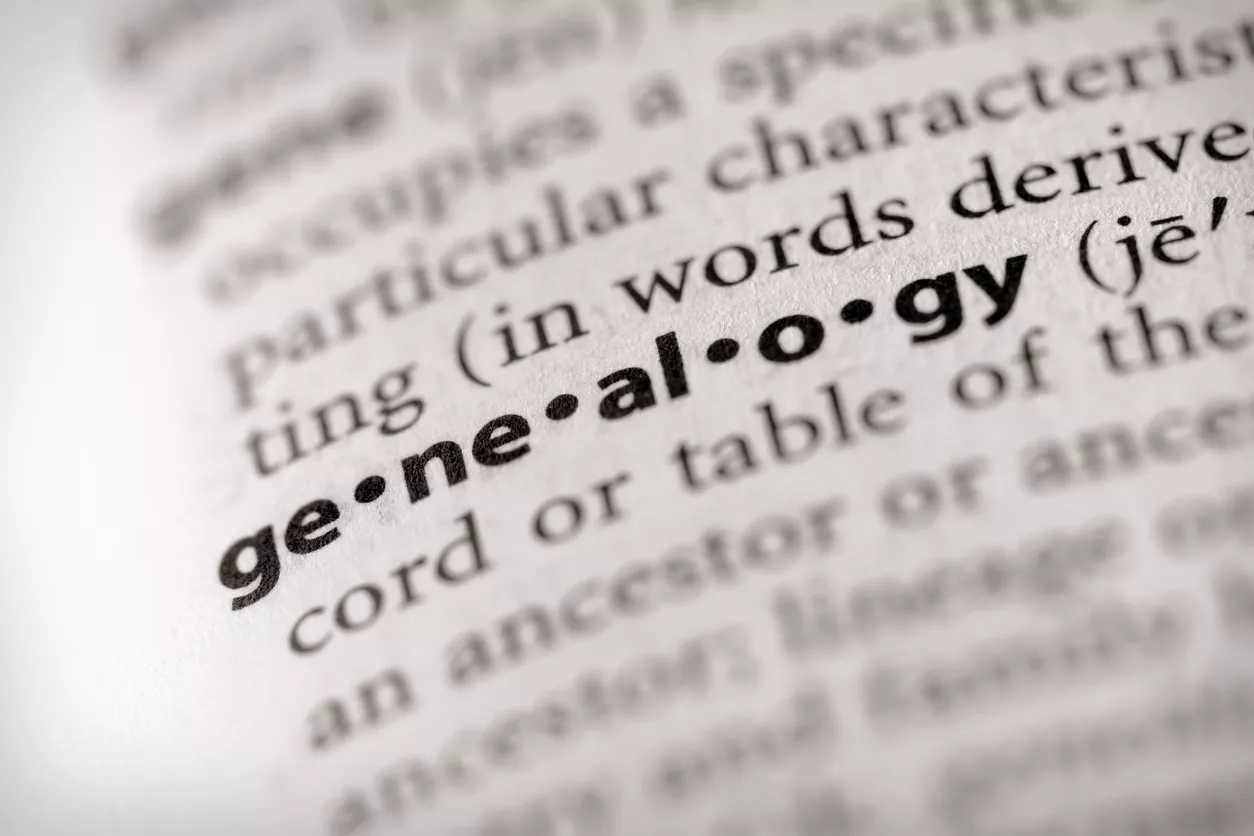
If you’ve just entered the world of genealogy, you may have heard many terms tossed around and haven’t been quite sure what everything meant.
In this post, we’ll set the record straight by defining the most important terms in genealogy.
Gene
A gene is a unit of inheritance: a sequence of DNA or RNA that is passed down from parent to child. We’ll explore specific terms relating to DNA below.
Genealogy
Genealogy is the line of descendancy traced continuously from an ancestor to a descendant. The word also refers to the study of ancestral lines.
Ancestors
Your ancestors are the people who came before you in your family. The term usually refers to relatives more distant than grandparents, such as your great-grandparents, great-great-grandparents, and so on. Ancestors may also include people from whom you are not directly descended, such as great-aunts and uncles.
Descendants
Descendants are the people who come after a given individual in the family. Children, grandchildren, great-grandchildren, and so on are all considered descendants.
Direct lineage vs. collateral relatives
Direct ancestors are people to whom you are related through parent-child relationships only. Aunts, uncles, siblings, and all other family members who are not direct ancestors or descendants are called “collateral relatives” or “indirect ancestors.”
Maiden name vs. married name
A “maiden” name is a somewhat archaic term for the surname a woman is born with, in contrast to the name she adopts when she marries (her “married” name). Obviously, this term only applies in cultures in which it is common practice for women to take their husbands’ surname when they marry.
Maternal and paternal lines
A maternal line is an ancestral line that goes through the mother, while a paternal line goes through the father.
Brick walls
Genealogists often use the term “brick wall” to describe a point in their research where they are unable to move forward with something — a kind of dead end. They break through a brick wall when they make a new discovery that helps them move past this dead end.
Pedigree
A pedigree is a record of the ancestry of a person or family, usually upper-class. The word is also commonly used in the animal world to indicate the lineage of a purebred.
Pedigree chart
A pedigree chart is like a family tree, but it records only the direct ancestry of a given individual — that is, the person’s parents, grandparents, great-grandparents, and so on, without siblings, aunts, uncles, or cousins.
Vital records
Vital records are records that relate to life events, such as birth, marriage, or death. These are an excellent starting point when setting out to find records of your ancestors.
Passenger lists
A passenger list is a record of the passengers on a ship that the crew must submit to customs at the port where the ship docks. If you find your ancestor’s name on a passenger list, you’ll know when they traveled and from where to where. There might be additional information about the passengers on the record, such as their age and country of origin.
Naturalization records
Naturalization is the process of becoming a citizen in a new country after living there for a certain period of time. Different countries have different criteria for naturalization, and these rules may change over time. A naturalization record is a document that records this process — either the petition submitted by the potential citizen, an oath of allegiance, or another related document.
Source
A genealogical source is the person, place, or thing where you obtained a given piece of information.
A primary source is a first-hand record of an event — such as a direct testimony from the person it happened to or who witnessed it, or a record that was created within a few days of the event based on the testimony of people who were there. Letters, diaries, vital records, and newspapers are all considered primary sources.
A secondary source is one step removed from the primary source, such as a book or scholarly article that refers to the primary source and analyzes it.
In general, primary sources are seen as more reliable, but it’s important to note that you can’t rely on them blindly, either. Someone’s memory may not be accurate, or the document may have recorded incorrect information for whatever reason. To verify the information you find in one source, it’s best to corroborate it with additional sources.
Citation
A citation is a reference to the source from which a given piece of information was obtained. It’s important to add citations to your family tree whenever possible to help you — or someone else looking at your research — retrace your steps in the future.
First cousins once removed
Cousin relationships can be extremely confusing! The “removed” part of the equation refers to the number of generations that separate you from this cousin — so for example, your father’s brother’s child is your first cousin, but your father’s first cousin is your first cousin once removed, because he comes from the same generation as your father. The “first,” “second,” “third” etc. part refers to the distance between you and the closest ancestor you share with this cousin.
For a full, detailed explanation of how this works, see this article on our Knowledge Base: What Does Once Removed Mean? Untangling Family Relationships
GEDCOM
A GEDCOM is the standard file type used to store genealogical information and transfer it from one digital genealogy platform to another. If you have built a family tree using software on your computer or online, chances are, you can download the tree as a GEDCOM, and upload it to a different platform if you like.





